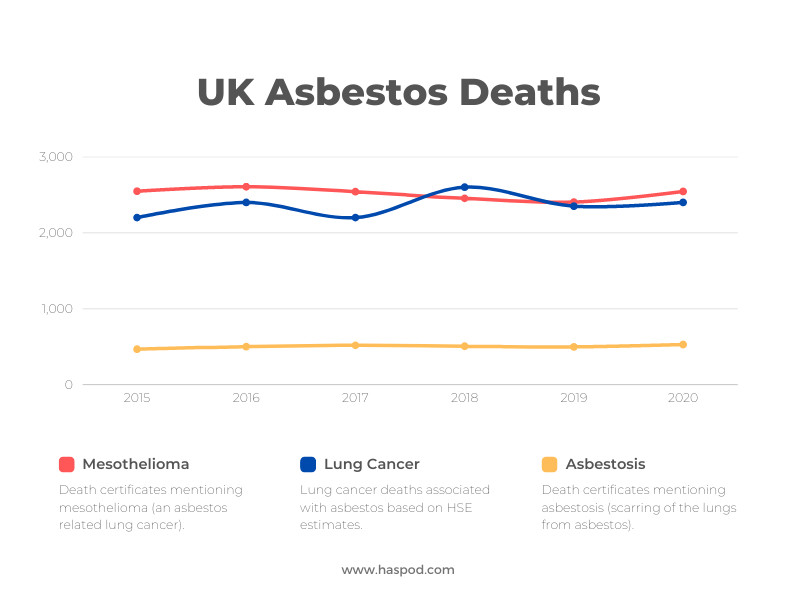29th July, 2025
10 Asbestos Awareness Questions And Answers Explained
If you have had, or are about to refresh, your asbestos awareness training, you should be able to answer these 10 asbestos awareness questions. Don't worry if you are not sure about the answers - we explain them in this post to help prepare you for your asbestos awareness training.

If you work in construction or any other industry where you may disturb (or be exposed to) asbestos-containing materials (ACM's), you need to have asbestos awareness training. This minimum level of asbestos training is required by law under the Control of Asbestos Regulations (CAR).
If you have had, or are about to refresh, your asbestos awareness, you should be able to answer these 10 asbestos awareness questions. Or, if you have never done the course before, this information should give you a good head start.
Don't worry if you are not sure about the answers - we explain them below to help prepare you for your asbestos awareness course.
Here's a video to give you an introduction to the questions, or a quick recap if it's been a while since you last refreshed your asbestos awareness certificate.
💡 If you think your asbestos knowledge is pretty good, skip the video and dive right into the questions below!
🤔 Try to answer the question yourself before looking at the answer and see how many you can get right!
Ok, let's get started.
1. In which year were all asbestos products banned in the UK?
Asbestos has been banned in the UK, but in which year were all asbestos products banned?
scroll down for the answer:
👇
👇
👇
✅ Answer: 1999.
Blue (crocidolite) asbestos and brown (amosite) asbestos were banned first in 1985. But it wasn't until white (chrysotile) asbestos was banned in 1999 that all asbestos products got banned in the UK.
The Asbestos (Prohibitions) (Amendment) Regulations 1999 came into force on the 24th of November 1999 and banned the importation and supply of all types of asbestos.
Find out more about when and why asbestos got banned in UK construction.
2. What are the three common types of asbestos?
Three types of asbestos were commonly used in the UK. Can you remember their names (not just their colours)?
scroll down for the answer:
👇
👇
👇
✅ Answer: Chrysotile, Amosite, Crocidolite.
Also known as white, brown and blue asbestos. Chrysotile, Amosite, and Crocidolite are the three common types of asbestos used in UK construction.
Find out more in asbestos types and colours explained.
3. What is a disease caused by asbestos?
There are a few diseases caused by asbestos, but can you name the biggest asbestos-related disease?
scroll down for the answer:
👇
👇
👇
✅ Answer: Mesothelioma.
Mesothelioma is one of the biggest asbestos-related diseases, killing around 2,500 people in the UK each year. However, asbestos is deadly and can cause a variety of different diseases.

You could also choose asbestosis, lung cancer, pleural plaques or stomach and larynx cancer as your answer.
Find out more in asbestos symptoms and related diseases.
4. When does an asbestos-containing material become dangerous?
What would you need to do to an asbestos material to put yourself at risk of asbestos exposure?
scroll down for the answer:
👇
👇
👇
✅ Answer: When it is disturbed.
If asbestos is left alone, it is low risk. You are not in immediate danger from asbestos materials if they are in good condition and intact. However, if asbestos-containing materials are disturbed, through sanding, drilling, cutting etc. or if they are in poor condition, then deadly asbestos fibres are released.
5. What is the main route of entry for asbestos fibres?
How are asbestos fibres most likely to get into your body and harm you?
scroll down for the answer:
👇
👇
👇
✅ Answer: Inhalation.
The main risk from asbestos fibres is through inhalation. It is the most common way that asbestos enters the human body. Asbestos fibres are so tiny they can remain suspended in the air for days, and when breathed in, they can become lodged in the lining of the lungs.

6. What type of asbestos survey is needed for construction work?
There are two types of asbestos survey, but which is needed before construction work can take place?
scroll down for the answer:
👇
👇
👇
✅ Answer: Refurbishment and demolition asbestos survey.
There are two types of asbestos survey, a management asbestos survey, and a refurbishment and demolition asbestos survey.
For building work, you need the refurbishment and demolition asbestos survey, which is the more intrusive type of asbestos survey. The building gets inspected with samples taken and tested to identify any asbestos materials present in the areas you are working on and disturbing as part of the project.
7. Why are smokers at increased risk from asbestos?
What is it about smokers that puts them at a higher-than-average risk when exposed to asbestos?
scroll down for the answer:
👇
👇
👇
✅ Answer: Because they have reduced lung function.
Smoking damages the tiny hairs in the throat and lungs and desensitises the lungs from smoke and particles. The immune system reduces the white blood cells sent to clean up the lungs.
Because of this reduced function, smokers are at a higher risk of asbestos-related diseases. When smokers get exposed to asbestos fibres, their lungs are less likely to fight off asbestos fibres.

8. Which buildings might contain asbestos?
Many buildings in the UK are likely to contain asbestos because it was so popular. Which buildings could contain asbestos?
scroll down for the answer:
👇
👇
👇
✅ Answer: Any built before 2000.
Because asbestos materials were used so heavily from the late 1800s to the ban in 1999, any building built before 2000 is likely to contain asbestos unless it has previously been removed.

Even buildings older than the late 1800s may have been refurbished during the period asbestos was in use and had asbestos products and materials installed then.
Unless you have an asbestos survey or removal records, always assume any building constructed before 2000 contains asbestos.
9. Why might you not know if you have disturbed asbestos?
When you disturb asbestos, you might not know about it. Why?
scroll down for the answer:
👇
👇
👇
✅ Answer: Because asbestos-related diseases take years to develop.
You don't die from asbestos exposure immediately. Asbestos-related diseases can develop over several years and often over decades. And it's hard to tell if a material contains asbestos without an asbestos survey. You can't know if a material contains asbestos just by looking at it.
With no immediate warning signs, make sure you check what type of materials you are working on.
10. How many people die in the UK each year from asbestos exposure?
Asbestos kills. Do you know how many people die each year in the UK from asbestos-related diseases?
scroll down for the answer:
👇
👇
👇
✅ Answer: Over 5000.
Currently, it is estimated that over 5000 people die each year from past asbestos exposure.

Around 2500 people die from mesothelioma each year. Around the same number of people die from asbestos-related lung cancer, and approximately 450 people die from asbestosis each year.
How did you do? Did you manage to answer all 10 questions correctly without looking at the answers? Download the free asbestos awareness toolbox talk to keep your knowledge fresh.
This article was written by Emma at HASpod. Emma has over 10 years experience in health and safety and BSc (Hons) Construction Management. She is NEBOSH qualified and Tech IOSH.
Are You Asbestos Aware?
Take our asbestos awareness elearning course and get your certificate today.
Asbestos Awareness CourseRecent posts like this...

10 Asbestos Awareness Questions And Answers Explained
If you have had, or are about to refresh, your asbestos awareness training, you should be able to answer these 10 asbestos awareness questions. Don't worry if you are not sure about the answers - we explain them in this post to help prepare you for your asbestos awareness training.
Read Post
The Risk Of Asbestos In Artex Ceilings
Many buildings contain artex and other textured coatings on walls and ceilings that may contain asbestos. The biggest risk is not the artex itself, but the potentially deadly fibres contained in it. In this post, we look at when you should be worried, and what the law says about asbestos in artex.
Read Post
The Two Types Of Asbestos Survey (And When You Need Them)
There are two types of asbestos survey, the management asbestos survey, and the refurbishment and demolition asbestos survey. A building may require one type, or both, depending on the use of the building and the work planned.
Read Post